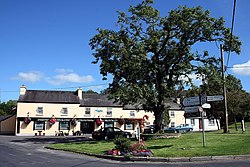Collinstown
| Collinstown Irish: Baile na gCailleach | |
| Westmeath | |
|---|---|
 Lough Lene Inn | |
| Location | |
| Grid reference: | N500673 |
| Location: | 53°38’50"N, 7°12’39"W |
| Data | |
| Population: | 326 (2006) |
| Post town: | Collinstown |
| Postcode: | N91 |
| Local Government | |
| Council: | Westmeath |
Collinstown is a village in northern Westmeath, situated on the R395 regional road overlooking Lough Lene. It lies 11 miles north-east of the county town of Mullingar and has a population of 700.
Contents
Village name
The Irish-language name of the village means 'town of the veiled women', owing to a convent once established on an island on nearby Lough Lene.
History
Collinstown has been an inhabited area since pre-Christian times.[1] West of the village, in the townland of Ranaghan, are the remains of several ringforts. At least one of these is attributed to the Viking chief Turgesius, who is said to have conquered Dublin. Turgesius built them on high ground overlooking Lough Lene for defensive purposes and dwelled there before being killed by Máel Sechnaill mac Maíl Ruanaid, the High King of Ireland.[2] In addition to this fort, Turgesius also had another upon the largest island of Lough Lene which still today bears his name, Turgesius Island.
The area also contains ancient burial-grounds associated with St Colman who was responsible for seven early Christian mass paths by which pilgrims travelled on foot through fields to Sunday mass, dating from the penal times.
Collinstown also has historic links with several religious orders: as well as a convent being established on Nun's Island, Lough Lene, to the north is the monastic complex of Fore Abbey.
The Lough Lene Bell
In 1882, the Royal Irish Academy was presented with the Lough Lene bell by the Barbavila estate proprietor, Mr William Barlow Smythe. The bell had been discovered in the lake the previous year by a boy fishing for eels on Castle Island, which was owned by Smythe at the time.
Given the close proximity to Fore Abbey, the estate owner Smythe concluded that the bell possibly belonged to the St Feichin Abbey. During the Viking and Anglo-Norman oppressions, it may have been transferred to Nun's Island, before eventually being hidden upon Castle Island.
The bell has a faint outline of the Christian Celtic cross upon opposing sides and has an ornamental peripheral border. Smythe pronounced that ornamentation was generally reserved for the cases or shrines for that era and was therefore most unusual. The bell appears similar to two other bells from that early Christian period. These had been found in Bangor, County Down in the year 1832, and another in Cashel, County Tipperary in 1849.
Smythe, the Barbavila owner, believed that the Lough Lene Bell was contemporary to these other 7th-century bells, supporting his theory that it was possible that it could have been a relic of St Feichins.
While the original bell remains within the National Museum, a half sized replica holds a place of pride as the Ceann Comhairle's bell in Dáil Éireann. This replica was presented to the Dáil in 1931 by the widow of Major Bryan Cooper, a former member of the House. In recent years, yet another replica has been cast from the mold of this bell and is on display in St Mary's (Roman Catholic) Church in Collinstown and also St Feichin's church in Fore.
Barbavila Manor
During the last century, the Barbavila House & Estate provided employment in the area. Houses, farm buildings, and animal dwellings were built from stone for employees throughout the immediate surroundings of Barbavilla in and around Collinstown. These stone houses, the old school, and farm buildings are protected through local heritage conservation laws. The notable feature of these buildings of stone is the roofing tile baked from local red colored clay, which was manufactured within the Barbavilla estate.[3] Some of these remaining buildings are identified by the small moss-green circles.[1]
Since 1964 Barbavilla has been home to the Irish Aluminium Company (Iralco), an industrial complex for the manufacture of automotive parts for major European car companies.
Sport
Collinstown boasts a rich hurling tradition. Lough Lene Gaels, the local hurling club, was founded in 1969 as a result of an amalgamation between the Collinstown, Fore, Glenidan and Rickardstown hurling clubs. The club has enjoyed plenty of success since its formation and has won the Westmeath Senior Hurling Championship on seven occasions since 1975. The Gaels enjoy a fierce rivalry with neighbouring side Castlepollard.
Bathing, Sailing, wind-surfing, authorized fishing,[4] and jetty facilities are available at the Lough Lene access point named locally as "The Cut" [5] about 2 km north of the village.
The local pitch-and-putt club is also popular.
Education
Scoil Mhuire Naisiúnta (St Mary's N.S.) is the local primary school.
References
- ↑ 1.0 1.1 "Archived copy". Archived from the original on 2007-09-27. https://web.archive.org/web/20070927081817/http://www.westmeathcoco.ie/docs/planning/Collinstown_Zoning.pdf. Retrieved 2006-12-28.
- ↑ A Popular History of Ireland: from the Earliest Period to the Emancipation of the Catholics By Thomas D'Arcy McGee- book-2 Chapter 2 from Nalanda Digital Library at NIT Calicut
- ↑ National archives Finding aid: Women's History Resources (Browse records)
- ↑ Angling in County Westmeath
- ↑ http://www.iol.ie/wmeathtc/carr/images/VIEW.JPG
Outside links
| ("Wikimedia Commons" has material about Collinstown) |
- Lough Lene Communities
- Westmeath County Council
- Gleann Álainn Residents Association Collinstown
- Viking Ireland Network school project
- Lough Lene "Monk's boat"
- Lough Lene Gaels
- Ballycomoyle GAA Club
- St. Colman (Colman Mac Luachain 6th/7th century)
- Betha Colmáin Maic Lúacháin, or, The Life of Colmán son of Lúachan
- Collinstown
- The family and estate papers of the Smythe family of Barbavilla, Collinstown, 1621 - 1930. Collection List No. 120 at the National Library of Ireland